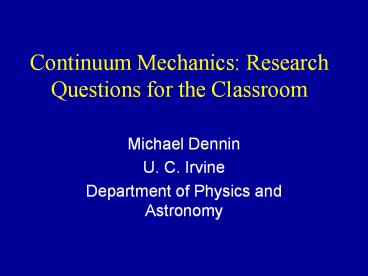Continuum Mechanics: Research Questions for the Classroom - PowerPoint PPT Presentation
Title:
Continuum Mechanics: Research Questions for the Classroom
Description:
Continuum Mechanics: Research Questions for the Classroom Michael Dennin U. C. Irvine Department of Physics and Astronomy – PowerPoint PPT presentation
Number of Views:122
Avg rating:3.0/5.0
Title: Continuum Mechanics: Research Questions for the Classroom
1
Continuum Mechanics Research Questions for the
Classroom
- Michael Dennin
- U. C. Irvine
- Department of Physics and Astronomy
2
One of the oddities of contemporary physics
education is the nearly complete absence of
continuum mechanics in the typical undergraduate
or graduate curriculum. Jerry Gollub, Reference
Frame, Physics Today, Dec. 2003.
3
What do we teach?
- Single particle classical
- Rigid body classical
- EM
- Quantum
- Waves (strings)
- Relativity
WHY DO WE TEACH THESE TOPICS?
4
How does it help understand
FLOW
JAMMING
VERSUS
5
What happened to continuum mechanics?
- Two Big Questions in Physics
- Transition from quantum to classical.
- Transition from single particle to continuum.
6
Educational Benefits
- Physically accessible tensors stress/strain.
- Practice with differential equations (ODE AND
PDE). - Exposure to CLASSICAL FIELD THEORY.
- Fun Demonstrations!!
- Relevance for undergrads moving into engineering
positions - CRITICAL BACKGROUND FOR CURRENT RESEARCH AREAS!!!
7
Jamming Phase Diagram
- Plasticity in molecular systems
- Glassy behavior in liquids
- Flow of multiphase materials granular, foams,
colloids, pastes, etc..
The J-point
Liu and Nagel, Nature v 396, 1998
8
WHAT ABOUT FOAMS?
http//www.joiff.com/technical/infoamation.htm
FOAM gas bubbles with liquid walls Size
microns to millimeters Useful parameter Liquid
fraction or gas fraction
Durian, UPENN
9
Main Features of Sheared foam
- Initial elastic response (yield stress)
- Flowing regimes
- Slow shear irregular stress response
- Fast shear smooth flow
- BUBBLES PLAYS CENTRAL ROLE
10
Definition of Terms Part I
T1 event Neighbor switching
11
Definition of Terms Part II
Outer barrier moves with V
flowing
stress
Ds
elastic
Dr
Strain g Dx/Dr Strain Rate dg/dt
v/Dr Viscosity h stress/(strain rate)
strain
Shear stress sxy F/L (two-dimensions) Stress
drop Ds
12
Apparatus
13
Schematic of Apparatus
Inner radius ri 3.84 cm Outer radius ro 7.43
cm Area fraction 0.95 Boundary conditions no
slip at both walls, but inner cylinder is free to
move.
14
Basic measurements
- Stress on inner cylinder
- Individual bubble motions
- Automatic tracking gives average properties and
topological rearrangements
15
Bubble Motions
16
One problem in continuum mechanics
What is a solid and a fluid?
(Is there a simple understanding of a broad range
of collective behavior?)
17
Continuum Facts Part I
Couette Geometry average stress, s, proportional
to 1/r2
Sample stress curve
Yield Stress
shear rate is a continuous function of r.
18
Effective Viscosity stress/(strain rate)
19
Shear Discontinuity
Yield stress fluid
solid
Power law fluid
J. Lauridsen, G. Chanan, M. Dennin, PRL, 2004
20
Another view
Exponential
21
Is this a phase transition?
THREE DIMENSIONAL Coussot, Raynaud, et al., PRL
88, 218301 (2002)
22
What are the questions?
- Correct description of fluctuations
- Statistical mechanics?
- Chaos theory?
- Spatial fluctuations?
- Something else?
23
How can we understand the average velocity
behavior?
- Why does it converge so quickly?
- What sets the critical radius?
- What is the role of T1 events?
24
T1Events
25
of neighbors
- distribution of neighbors
- changes in distribution
- size separation?
- ordering/disorder?
26
Conclusions
- Even continuum mechanics has interesting physics
questions left. - We need to inspire our students with exciting,
challenging QUESTIONS, not just elegant past
solutions. - One such question Can we describe collective
behavior based on simple principles?
27
Thanks to
Michael Twardos John Lauridsen Gregory
Chanan Yuhong Wang Kapil Krishan
Funded by Department of Energy grant
DE-FG02-03ED46071, Sloan Foundation, Petroleum
Research Fund, and UCI UROP































